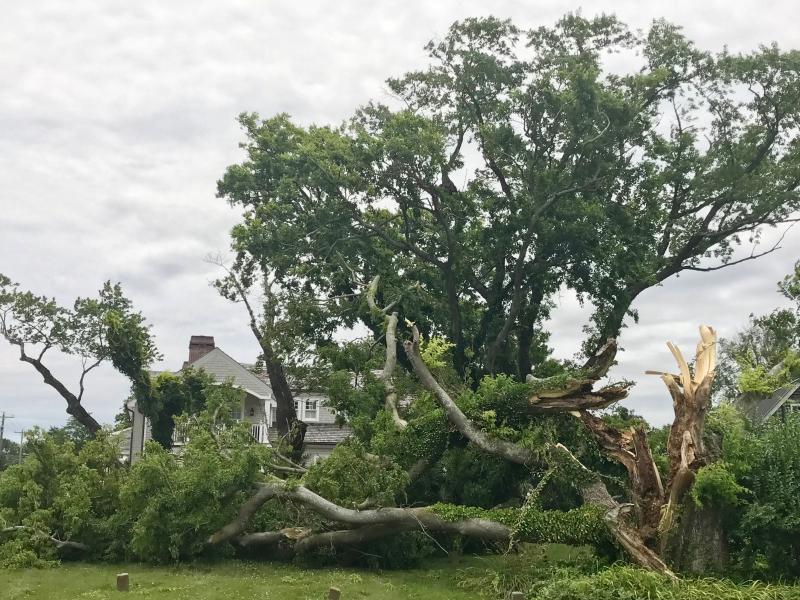Lost tree, lost ring, thunder, rain and lightning
It didn't exactly blow like hell, but the storm that jumped on the Cape Region last Friday morning, July 6, made a big impression real fast. Serious flashes of lightning followed by booming claps of thunder ushered in more than an inch of rain.
For the next hour, Lewes Fire Department volunteers scrambled to answer three different alarms triggered by lightning strikes. Two were less than a quarter-mile apart, in the communities along the Gills Neck corridor: one in Wolfe Runne, the other in Hawkseye. "There was damage from those fires, but really we got lucky on all of them," said Glenn Marshall, spokesman for the department. "They could have been much worse, especially because of gas lines that were near the fires."
The third lightning alarm was for a home in the Briarwood community near Love Creek.
The winds that blew the storm in had their own ferocity. They were of the straight-line variety and came in hard and steady from the southwest.
The most notable casualty was the state champion hackberry tree located in St. George's African Methodist Episcopal Church Cemetery on Pilottown Road. With a trunk diameter of 40 inches, a height of 46 feet and a crown spread of 72 feet, the champion that is no more dominated the historic graveyard. Friday's wind toppled the tree near its base, revealing extensive interior rot. The tree lost a great deal of its counterbalance within the past year. One of its main branches, at least 40 feet long and reaching out parallel to the ground about 10 feet up, broke off. That didn't give the main stem much to hold back with when Friday's sustained gust in the 30-mile-per-hour range filled the fully leaved canopy and sent the tree to its end.
The age of the tree is debatable. Lewes Historical Society Executive Director Mike DiPaolo said one of the former iterations of St. George's AME Church was in the middle of the cemetery where the champion hackberry and its nearby twin have stood for decades. "I think the last church was there until the middle 1930s, so I'd say the trees came after the church came down." That would put the age of the tree at about 80.
Mike Valenti, forestry administrator for the Delaware Forestry Service, looked up a tree-age calculator table on the Morton Arboretum site. "That site estimates hackberries of 30-inch diameter to be about 110 years old. This one was quite a bit larger. Extrapolating out to its 40-inch diameter, I'd guess the age of that tree to be more in the 140-year range. And it wasn't uncommon back then for people to plant trees in pairs, kind of like bride and groom trees."
If the downed tree and its partner are that old, it would put them in the expected lifespan of hackberries, between 150 and 200 years.
It would also put their beginnings in the late 1860s and early 1870s when an African-American shipbuilder in Lewes named Peter Lewis donated the land for a church and cemetery.
That all, of course, is academic now since Lewes's one state champion tree, thanks to last Friday's storm, is no more.
Ending on a happy note
Phil Haddad and his wife, Bonnie Heebner, are happy people this week.
Early last December, on Lewes Beach near New Jersey Avenue, they exchanged rings that Bonnie had designed to commemorate their love.
When winter turned to summer, Phil found himself happily married and frolicking on the beach with one of Bonnie's grandchildren on the Fourth of July. He was in the water when he noticed that his ring had slipped from his finger.
Distraught, he started a frantic search along with several other friends and relatives.
With those efforts fruitless, he reported his loss to Lewes police on the off chance someone would find the ring. They took down the information but could do little else. Phil and Bonnie tell the rest of the story: "I turned to the Cape Gazette," said Phil, "for assistance in placing an advertisement – with a cash reward for the person finding the ring. Four days later, on Sunday, July 8, 2018, after spending four days tossed around by the tides on Lewes Beach, the ring was found by Bill C."
An amateur but serious treasure hunter, Bill used metal-detecting equipment, tide tables, and other information to narrow his search. "Within 20 minutes, he was successful," said Phil.
"Finding the ring, which means so very much to Phil and me, was nothing short of a miracle," said Bonnie. "My heartfelt thanks go out to all."
The human resources around here are amazing.
You never know until you ask. And the Cape Gazette is thrilled, of course, to have played a role in connecting the problem with the solution.






















































